
| KIT: | Tamiya 1/48 P-51D |
| KIT #: | 61040 |
| PRICE: | $26.00 MSRP |
| DECALS: | Three options |
| REVIEWER: | Tom Cleaver |
| NOTES: |

| HISTORY |
The 361st Fighter Group:
The 361st Fighter Group, comprising the 374th, 375th and 376th Fighter Squadrons, came into existence on February 10, 1943 at Richmond Army Air Base, Virginia. The unit was formed with trained personnel from the 327th Fighter Group, and new graduates of flight schools and technical schools. The Commanding Officer was Major Thomas J.J. Christian, Jr., great-grandson of the famous Civil War general “Stonewall” Jackson.
Following training through most of 1943 on the P-47 Thunderbolt, the 361st was ordered to join the 8th Air Force in England and moved to the United Kingdom in November 1943, arriving on November 29. After an overnight train journey, the unit arrived at RAF Bottisham, Cambridgeshire, where they were assigned to VIII Fighter Command, 8th Air Force.
After training in England, the 361st flew their first combat mission, a”Rodeo” to St. Omer, France, on January 23, 1944. The Group claimed its first victories on January 30, when pilots from the 374th Fighter Squadron shot down four Bf-109s near Rheine, Germany. The unit gained their combat spurs during “Big Week” in February. On March 6, while providing withdrawal support for the first Berlin mission, the group claimed five Fw-190s destroyed for no loss and followed this up on March 8 on the second Berlin mission with claims for 2more Bf-109s.
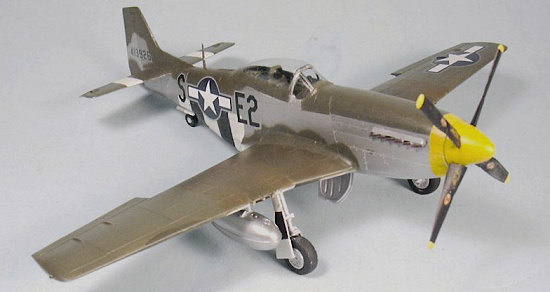 On March 11, Lt. Col.
Christian and four other pilots from the group participated in training for
strafing and dive-bombing missions, which would become a speciality of the 361st.
Their first strafing mission was flown against the German airfield at Chartres
on March 17.
On March 11, Lt. Col.
Christian and four other pilots from the group participated in training for
strafing and dive-bombing missions, which would become a speciality of the 361st.
Their first strafing mission was flown against the German airfield at Chartres
on March 17.
On May 1,1944, the 361st received 17 new P-51B Mustangs and began re-equipment from the P-47. The first all-Mustang mission was flown on May 13, and on May 19 the 361st flew their first escort mission to Berlin. On May 27, Maj. George L. Merritt, Jr., commanding the 375th Fighter Squadron, became the group’s first ace when he shot down a Fw-190 near Lille.
The 361st was in the thick of things with the invasion of Normandy in June, flying six strafing and dive-bombing missions on June 6 alone, during which 15 locomotives and an ammunition train were destroyed, as well a 23 trucks and armoured cars and two enemy aircraft on the ground. The group continued to fly ground attack missions throughout June and July during the Battle of Normandy, demonstrating real proficiency in dive-bombing, and also demonstrating the vulnerability of the Mustang, with it’s liquid-cooled engine, to ground fire as 10 pilots were killed or posted Missing in Action during that time. On June 29, the group scored 16 aircraft destroyed on a strafing mission to Oschersleben, Germany. On August 12, 1944, four dive-bombing and strafing missions were flown against rail transportation targets in France with the loss of Lts. John E. Engstrom and Merle C. Rainey of the 375th FS, Lt. Clarence E. Zieske of the 374th FS and the Group Commander, Col. Thomas J.J. Christian, Jr.
In September,1944, the group provided air cover for Operation Market Garden, the airborne assault on northern Holland that ended in the defeat of the British 6th Airborne Division and the likely extension of the war by 5-6 months as a result of the British failure. September also saw Lt. Urban Drew of the 375th FS open his score by shooting down an He-111 on September 18. In October, Drew would make a name for himself by shooting down two new Me-262s of Kommando Nowotny at Achmer as they were landing.
Even though the group scored well in aerial combat throughout the summer and
fall of 1944, they were still better-known as a tactical unit for their
dive-bombing and strafing missions. In December 23, 1944, the Group sent 60
P-51s and pilots, nine ground officers and 137 enlisted men to airdrome A-64 at
St. Dizier, France, to support 9th AF operations in the Battle of the
Bulge, commencing assignment to the tactical battles on the continent that would
last until April 1945. During these four months, the group flew escort missions
for the 8th Air Force over Germany, for medium bombers of the 9th
Air Force over the battlefield, and for RAF Heavies on their daylight missions
into western Germany, as well as flying dive-bombing and ground attack missions
over 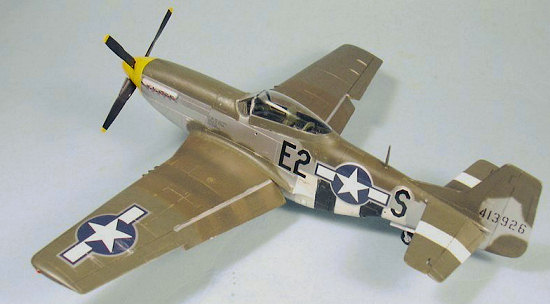 Holland and Western
Germany from Chievres, Belgium, a base they shared with the 352nd
Fighter Group of the 8th Air Force. While flying escort missions,
the group also became specialists at skipping bombs into railway tunnels to
destroy hidden trains. In March, the group flew air cover over the Bridge at
Remagen, where the first penetration was made by Allied ground forces of Germany
proper. On March 24, the 361st flew six missions in support of the
Allied airborne crossing of the Rhine.
Holland and Western
Germany from Chievres, Belgium, a base they shared with the 352nd
Fighter Group of the 8th Air Force. While flying escort missions,
the group also became specialists at skipping bombs into railway tunnels to
destroy hidden trains. In March, the group flew air cover over the Bridge at
Remagen, where the first penetration was made by Allied ground forces of Germany
proper. On March 24, the 361st flew six missions in support of the
Allied airborne crossing of the Rhine.
On April 4, 1945, during a target escort mission to Parchim airfield, the 361st had their last aerial battle with the Luftwaffe. The B-24s were attacked three times by 30 Me262s, during which Lt. James T. Sloan of the 374th FS claimed one destroyed, while other pilots of the 374th and 375th squadrons claimed 12 Me262s damaged, for no loss.
On April 8,the 361st received orders to return to their English base at Little Walden, which was accomplished on April 9 at the conclusion of an uneventful escort mission to Lechfeld. On April 17, one section of the Group escorted 2nd Air Division bombers attacking rail targets in Czechoslovakia while a second section strafed Pilsen and Eger airfields, claiming six destroyed and seven damaged for the last claims of the war.
On May 8, 1945, the war in Europe was over. The 361st had flown 441 combat missions in 15 months of operations from air bases in England, France and Belgium, during which the Group claimed 226 enemy aircraft destroyed in the air and 105 on the ground, for the loss of 81 aircraft. On May 18, war-wearing P-37s arrived at Little Walden and the 361st began retraining on the Thunderbolt for transfer to the Pacific, which never happened with the end of the Second World War on August 15.
Urban Drew:
Urban
L. Drew joined the USAAF in October 1942 and graduated in Class 43-I, where he
was assigned to the replacement base at Bartow, Florida to learn to fly the
P-51; after completion of the course he remained as an instructor until
receiving an assignment to the 375th Fighter Squadron, 361st
Fighter Group in May 1944. While a junior pilot, Drew had more P-51 time than
anyone else in the group, which had just transitioned to the P-51 that month,
and he did quite a bit of instruction of pilots with more combat experience than
he had. During his tour with the “Yellowjackets,” Drew flew 75 missions and rose
to command first “A” Flight and later the 375th Squadron, during
which time he scored 6 victories. His most notable combat came on October 7,
1944, when he 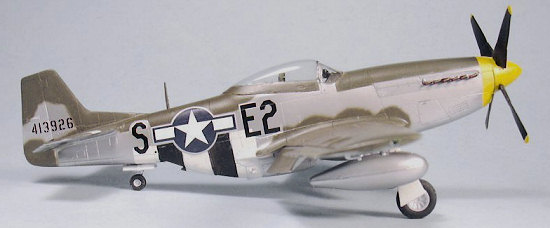 shot down two
Me-262s of Kommando Nowotny and became the first Allied pilot to shoot down the
new jet fighter, and one of very few to shoot down two. Years later, he was
awarded the Air Force Cross for this. He also sank the Bv-238 V1 prototype
six-engine flying boat at Lake Schaal by strafing with the three other pilots of
his flight. Following his ETO tour, Drew was assigned to the 413th Squadron,
414th Fighter Group, flying P-47N’s at Iwo Jima in 1945. After the war, he
helped organize the 127th Fighter Group of the Michigan Air National Guard and
later was appointed the first Air Adjutant General of the State of Michigan.
After operating an aviation business in Britain and South Africa, Urban Drew
retired to San Diego, where he still lives.
shot down two
Me-262s of Kommando Nowotny and became the first Allied pilot to shoot down the
new jet fighter, and one of very few to shoot down two. Years later, he was
awarded the Air Force Cross for this. He also sank the Bv-238 V1 prototype
six-engine flying boat at Lake Schaal by strafing with the three other pilots of
his flight. Following his ETO tour, Drew was assigned to the 413th Squadron,
414th Fighter Group, flying P-47N’s at Iwo Jima in 1945. After the war, he
helped organize the 127th Fighter Group of the Michigan Air National Guard and
later was appointed the first Air Adjutant General of the State of Michigan.
After operating an aviation business in Britain and South Africa, Urban Drew
retired to San Diego, where he still lives.
The Airplane:
There are a very few controversies in modeling that can define friendships good or bad, and are likely to never ever be brought to a final, definitive end by the introduction of
evidence, informed historical deduction, detailed chemical analysis of the photographic development process, or anything else.
One of these is: did the P‑51s of the 361st Fighter Group in the summer of 1944 have green or blue camouflaged upper surfaces. I have seen good friends stop speaking to each other over this issue.
All this sturm und drang comes from a series of photographs taken of four aircraft of the 361st in July, 1944, which are well-known because they are among the few photos taken during World War II in color. One could almost wish they were in the then-standard black-and-white, since they would have generated less controversy. While the most controversy has swirled particularly around the P-51 flown by the group commander, Lt. Col. Thomas J.J. Christian, which was certainly the most colorful of the four aircraft, the controversy has extended to the other three.
 The problem revolves
around the aging of color negatives and the color shifts that naturally occur,
the different results that can be obtained through use of different filters,
questions of what colors a fighter group might have used at which period of the
war, whether to accept the testimony of members of the group over that of four
young English “spotters,” ad nauseam.
The problem revolves
around the aging of color negatives and the color shifts that naturally occur,
the different results that can be obtained through use of different filters,
questions of what colors a fighter group might have used at which period of the
war, whether to accept the testimony of members of the group over that of four
young English “spotters,” ad nauseam.
This controversy has been made even more prominent over the years by warbird owners who have restored their airplanes in one variation or another of the two schemes, with varying aesthetic results. Back in the 1970s, one warbird was restored as Christian’s “Lou IV” with a very beautiful Royal Blue scheme, while another - owned by EAA founder Paul Poberezny - was painted in a darker blue as “Paul I”. At about the same time, Urban Drew - who was the pilot of P-51D E2-S in the photos and the only survivor of the four pilots - stated categorically that the airplanes of the 361st had been painted with U.S. Olive Drab and RAF Dark Green on their upper surfaces in May 1944 in expectation of being based on the Continent following the coming invasion of Europe. Several other surviving members of the group agreed with this, while four English “airplane spotters” - one of whom went on to become the well-known aviation historian Michael J.F. Bowyer - stated that they had seen these aircraft, and they were painted blue.
Well-known aviation color historian Dana Bell comes down quite solidly on the side of the blue Mustangs. His argument is as follows:
1. British spotters: Most compelling is the fact that at least four wartime spotters, on separate occasions, independently recorded blue upper surface colors on 361st Mustangs. M.J.F. Bowyer was among the witnesses, and he has seen the other notebooks. While several vets have denied the use of blue, I consider it more likely that some would forget a color than those spotters would independently invent it.
2. Color photos. I dealt with the surviving USAF color originals for over 20 years. I never felt that they showed a definite blue color, but they clearly showed some aircraft to be a different shade than the green which is clearly visible on other aircraft in the same shots. It is clear that if there's a blue in those photos, it is not the same bright blue that appears on present-day restorations/warbirds.
3. Use of blue by other units. There is an ongoing argument that it made no sense to use blue camouflage; yet there is no argument that the 56th FG used blue on some of its P-47s. Remember, the main reason that paint was being added in June 44 was to cover the upper surface Invasion Stripes - nearly anything would do the job.
Allow me to disagree with my good friend Dana Bell on each point.
 As to the British
Spotters, I would want to know what the sky conditions were on the days they
observed these airplanes. I say that because - as an aviation photographer for
the past 30 years who has shot airplanes in color - I can attest to the fact
that sky conditions, the presence or absence of clouds, the amount of the sky
covered by clouds, etc., can have a truly astounding effect on the “color” of an
airplane when viewed by either the camera or the human eye. I often marvel at a
slide I took of Bob Hoover’s yellow P-51D against what looks like a “magenta”
sky (it was cloudy and overcast that morning as I aimed the camera up), with a
purplish-pink airplane center frame!! Trust me, Hoover’s airplane was
definitely yellow. Given that the usual condition of the British sky is
overcast to one degree or another, I believe a dark “blue-base” green could
easily look “blue” to the untrained observer (and - as a former juvenile
“airplane spotter” myself, I can attest to the fact that while we may have been
knowledgeable, we were never “trained observers”). No one can say one way or
the other what the sky looked like on the days these spotters saw what they say
they saw. Thus, the evidence is at best “indecisive.”
As to the British
Spotters, I would want to know what the sky conditions were on the days they
observed these airplanes. I say that because - as an aviation photographer for
the past 30 years who has shot airplanes in color - I can attest to the fact
that sky conditions, the presence or absence of clouds, the amount of the sky
covered by clouds, etc., can have a truly astounding effect on the “color” of an
airplane when viewed by either the camera or the human eye. I often marvel at a
slide I took of Bob Hoover’s yellow P-51D against what looks like a “magenta”
sky (it was cloudy and overcast that morning as I aimed the camera up), with a
purplish-pink airplane center frame!! Trust me, Hoover’s airplane was
definitely yellow. Given that the usual condition of the British sky is
overcast to one degree or another, I believe a dark “blue-base” green could
easily look “blue” to the untrained observer (and - as a former juvenile
“airplane spotter” myself, I can attest to the fact that while we may have been
knowledgeable, we were never “trained observers”). No one can say one way or
the other what the sky looked like on the days these spotters saw what they say
they saw. Thus, the evidence is at best “indecisive.”
Color Photos: As Dana says: “I dealt with the surviving USAF color originals for over 20 years. I never felt that they showed a definite blue color, but they clearly showed some aircraft to be a different shade than the green which is clearly visible on other aircraft in the same shots.” He is absolutely right about this - there are in fact different colors on the different airplanes, and that has muddied the water for analysts ever since. Not to mention that color negative film and color slides can change color over the years. I have slides taken only 25 years ago, with modern film stock, that have shifted considerably from the colors I know were present the day the picture was taken. For a color negative or a color slide from 60 years ago to even be viewable is amazing, and it is merely a matter of changing the order of the filters in making a print to come out with a “blue” or a “green” subject. Again, the evidence is indecisive.
Use of blue as “camouflage” by other units. In the USAAF, the only other unit that used blue as “camouflage” is the 56th Fighter Group, and then only on their P-47Ms, which the unit flew between February 1945 and the end of the war. Given that the “camouflage color” of another squadron in the unit at the time was black, it is quite simple to see that this “camouflage” was more in the form of “unit heraldry” than it was actual camouflage. Considering that in the Spring of 1945, USAAF units in the ETO hardly had any reason at all for “camouflage,” the 63rd Fighter Squadron’s use of what was most likely Azure and Mediterranean Blue - which make an attractive look that has nothing whatsoever to do with “camouflage” - it is impossible to argue this as evidence when looking at a unit camouflaging its aircraft when the issue was still in doubt and the 8th A.F. was urging its fighter units to adopt camouflage of their natural-metal-finish aircraft in light of a possible move to the Continent following the invasion. Look at every other 8th AF fighter group that brought back camouflage at that time: they were concerned about hiding their aircraft on airfields in France, and they used RAF Green and Olive Drab, whichever was most easily available. Blue is not a color one uses to blend in with ground cover.
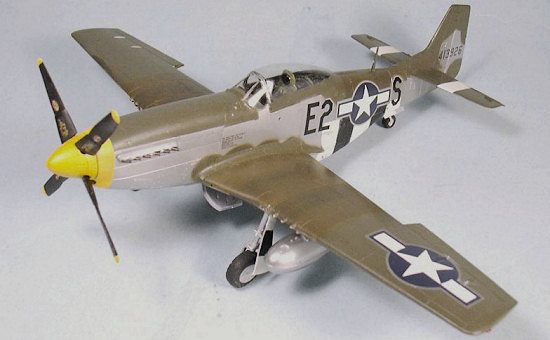 And now, my own
argument as to why there were no blue Mustangs in the 361st Fighter
Group: Lt. Col. Thomas J.J. Christian would have come down on the man who made
such a suggestion like the well-known “ton of bricks.” Christian was a pre-war
USAAC pilot, and was described by at least one member of the 361st I
have spoken to as “very G.I.” That was intended as a compliment. He was known
as a stickler for “the book.” Most members of the 361st remember him
with respect - a good thing that comes from “going by the book.” Consider also
that the 361st was not a “high-scoring” group. That is the result of
“going by the book,” the “book” in 1943 (when the group was founded) being that
the role of fighters as escorts was to stick with the bombers and not act
offensively by going after enemy fighters as they formed up. The practitioners
of “offensive escort theory” fought long and hard, and were in the minority of
fighter group commanders in the 8th AF. History may have proven
those who said “the best defense is a good offense” were right, but in 1943-44,
Christian was in the middle of the mainstream with his policy of defending the
bombers through close escort and not going after the enemy offensively. If one
accepts Christian was a “by the book” leader, then looking at the photographs
takes on a different dimension.
And now, my own
argument as to why there were no blue Mustangs in the 361st Fighter
Group: Lt. Col. Thomas J.J. Christian would have come down on the man who made
such a suggestion like the well-known “ton of bricks.” Christian was a pre-war
USAAC pilot, and was described by at least one member of the 361st I
have spoken to as “very G.I.” That was intended as a compliment. He was known
as a stickler for “the book.” Most members of the 361st remember him
with respect - a good thing that comes from “going by the book.” Consider also
that the 361st was not a “high-scoring” group. That is the result of
“going by the book,” the “book” in 1943 (when the group was founded) being that
the role of fighters as escorts was to stick with the bombers and not act
offensively by going after enemy fighters as they formed up. The practitioners
of “offensive escort theory” fought long and hard, and were in the minority of
fighter group commanders in the 8th AF. History may have proven
those who said “the best defense is a good offense” were right, but in 1943-44,
Christian was in the middle of the mainstream with his policy of defending the
bombers through close escort and not going after the enemy offensively. If one
accepts Christian was a “by the book” leader, then looking at the photographs
takes on a different dimension.
Look at “E2*S”, the airplane that almost all observers agree was in Olive Drab upper surfaces. This is a P-51D-15 - the first sub-type with the dorsal fin extension - and by that fact obviously an airplane that arrived in the unit later than the two P-51D-5s without the fin extension. “E2*S” has two colors, a lighter one over the area of the fuselage where the D-Day stripes were overpainted on the fuselage. To me this confirms Urban Drew’s statement that the airplanes were painted in British Green and Olive Drab, with E2-S having been painted Olive Drab overall - the same color as the anti-glare panel on the nose - with a thinner coat of the same color over the upper D-Day stripes. You can read my other review here of Christian’s airplane, “Lou IV,” as to why I think it is an airplane originally camouflaged on its upper surfaces in British Dark Green, with the areas of the D-Day stripes overpainted in Olive Drab.
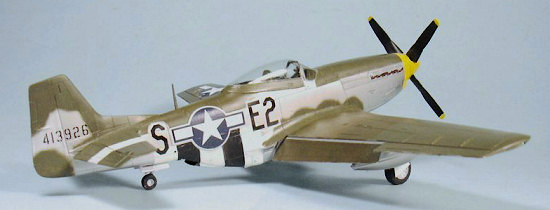 British Dark Green has
blue in it. U.S. Olive Drab is a color that faded rapidly at high altitude under
ultraviolet sunlight, and took on a distinct purplish hue. Now, put airplanes
painted with a blue-base green and a UV-faded Olive Drab on their upper
surfaces, as they come down final approach to land on a cloudy day in England,
perhaps with a bit of rain threatening, as it does in summer, which adds a blue
cast to the dark clouds, and a 14-year old “plane spotter” is not lying when he
says “It was blue.” That’s what he saw.
British Dark Green has
blue in it. U.S. Olive Drab is a color that faded rapidly at high altitude under
ultraviolet sunlight, and took on a distinct purplish hue. Now, put airplanes
painted with a blue-base green and a UV-faded Olive Drab on their upper
surfaces, as they come down final approach to land on a cloudy day in England,
perhaps with a bit of rain threatening, as it does in summer, which adds a blue
cast to the dark clouds, and a 14-year old “plane spotter” is not lying when he
says “It was blue.” That’s what he saw.
Can I prove any of this? I can prove that certain colors look certain ways in certain sky conditions. I can point to the fact that if one is going to base aircraft in Northern France and be worried about their vulnerability to being seen from the air and attacked while on the ground, logic would exclude any shade of blue as a useful “camouflage.” I can also tell you that Ben Drew, at age 82, definitely is “firing on all cylinders” above the eyebrows, and his memory is very good. If he says they were green and olive drab, I believe him.
Your mileage may differ.
| THE KIT |
It's by Tamiya.
| CONSTRUCTION |
I have a policy that, when I have a well-built model, if it turns out that time has not been kind to the finish, or if better alternatives to markings come along, then that model is a prime candidate to head for the paint stripper shop, then to the paint shop for a new scheme. Given the price of models nowadays, and the fact that it’s virtually impossible not to assemble a great model from the Tamiya P-51 kits, this policy makes good economic sense to me.
When I received the Falcon Vacuform “P-51 Mustang” set, one of the canopies included was the early “teardrop” canopy, which has a lower profile line than either the “Los Angeles” or “Dallas” canopies that were used on most P-51Ds. The instructions noted that one airplane that most notably used this early canopy was “E2-S,” the P-51D flown by Urban Drew in the famous photographs. Going through the decal dungeon, I noticed I had several of the original Tamiya decal sheets for the kit, which included the proper markings for this airplane.
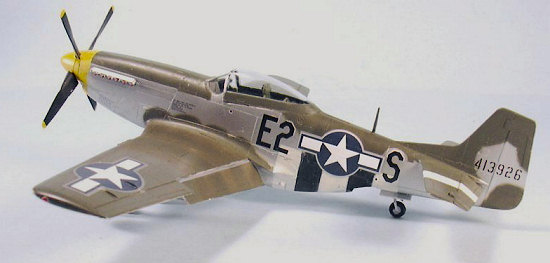 Strip
A Kit:
Strip
A Kit:
There are three ways to strip paint off a model. If you are one of those who thinks using oven cleaner is a viable option, perhaps you will want to read another article.
There are two good strippers available. Polly S “ELO” (Easy Lift Off) and Strip-A-Kit. If you use ELO, you have to be careful it doesn’t eat the model; don’t put it on for more than 10 minutes at a time, or you will find the plastic joints coming apart in strange (and not nice) ways. You can completely ruin a canopy by dipping it in ELO; other canopies will be fine, since it depends on the plastic - and the only way you will learn which is which is to “just do it.” I have used ELO many times, and likely will again. That said....
Strip-A-Kit may not work as quickly as ELO, and may require more applications to get down to bare plastic. But you will never ever have the model come apart at the joints, and there is no clear plastic that will craze if SAK is applied to it. SAK will not disassemble your model, as oven cleaner will do. In other words, your model is safe.
Need I say more as to which is the best to use?
After about 4 different applications of SAK (break through the varnish, hit the big areas, take off the paint below the decals, get rid of the paint in the difficult areas), the model was down to some left-over SnJ that wasn’t going to come off without more work than was needed, since painting over the SnJ was easy to do.
| COLORS AND MARKINGS |
Painting:
I started by painting the areas of the black D-Day stripes, a bit wider than they would be in the end. This makes painting white over the black difficult, but the end result is the white looks “distressed,” which is the way D-Day stripes should look, since they were not applied with permanent paint. I also painted the area that would be yellow on the nose with an undercoat of white at that point.
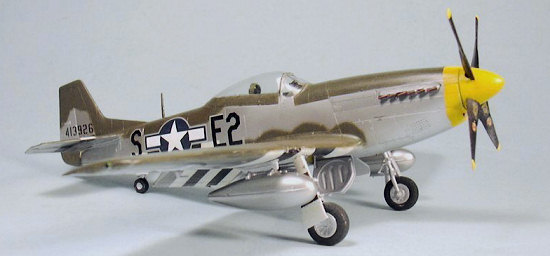 With the D-Day stripes
masked off, I painted the yellow nose, then masked it off.
With the D-Day stripes
masked off, I painted the yellow nose, then masked it off.
I then painted the fuselage sides and lower surfaces with SnJ Aluminum. I painted the fabric elevators and rudder with Model Master non-buffing Aluminum and sealed it, to show the fabric areas that were painted with aluminum dope.
I then painted the upper surfaces of the tail and the outer surfaces of the wing with Gunze-Sangyo “Olive Drab 2 - US Aircraft,” and “UV-faded” it with a bit of Gunze-Sangyo “Dark Sea Grey” which has a distinct purplish cast. Fortunately, there are photos of both sides of these airplanes, so I was able to get the differences in camouflage spray pattern. I then painted the areas where the D-Day stripes were overpainted with Gunze Sangyo “Olive Drab 1 - US Tanks", which would be darker and therefore “fresher, fading it with some more of the “Dark Sea Grey.”
Decals:
I used the Tamiya silver backing for the upper surface national insignia, as well as the serial number and squadron codes. I used national insignia from an older MicroScale P-51 sheet from the decal dungeon.
| FINAL BITS |
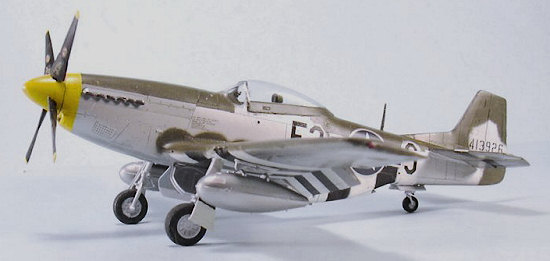 Photos show this
airplane with a “semi-gloss” finish to the paint. That wasn’t the paint: it was
automobile polish applied to the airplane by the ground crew. After a final
coat of Future over the camouflaged areas, I gave the upper surfaces a coat of
Xtracrylix Satin Varnish, which gave the semi-gloss “waxed look” I was wanting.
Photos show this
airplane with a “semi-gloss” finish to the paint. That wasn’t the paint: it was
automobile polish applied to the airplane by the ground crew. After a final
coat of Future over the camouflaged areas, I gave the upper surfaces a coat of
Xtracrylix Satin Varnish, which gave the semi-gloss “waxed look” I was wanting.
I then reinstalled the exhausts, and applied exhaust staining with Tamiya “Smoke,” and attached the 75-gallon metal drop tanks the real airplane was carrying when photographed.
I also decided to mount the canopy in the closed position, which shows the “teardrop” shape of this canopy better than would be the case if it was posed open. The Falcon canopies all come separated by windscreen and canopy, so I had to mate the two carefully with white glue to get the proper fit.
| CONCLUSIONS |
I call these four airplanes of the 361st “Paris Hilton” airplanes, since they are famous for being famous. To me, this model looks like the photograph. Its colors fit logically with the decisions that would have been made by the CO of the 361st Fighter Group in the summer of 1944. It seems “right.” But then again, there are at least two “blue” 361st FG Mustangs out in the model museum at Planes of Fame, built by me. Like I said - your mileage may differ.
Kit courtesy of my wallet. Vacuform canopies courtesy Falcon Industries.
November 2006
If you would like your product reviewed fairly and quickly by a site that has over 325,000 visitors a month, please contact me or see other details in the Note to Contributors.